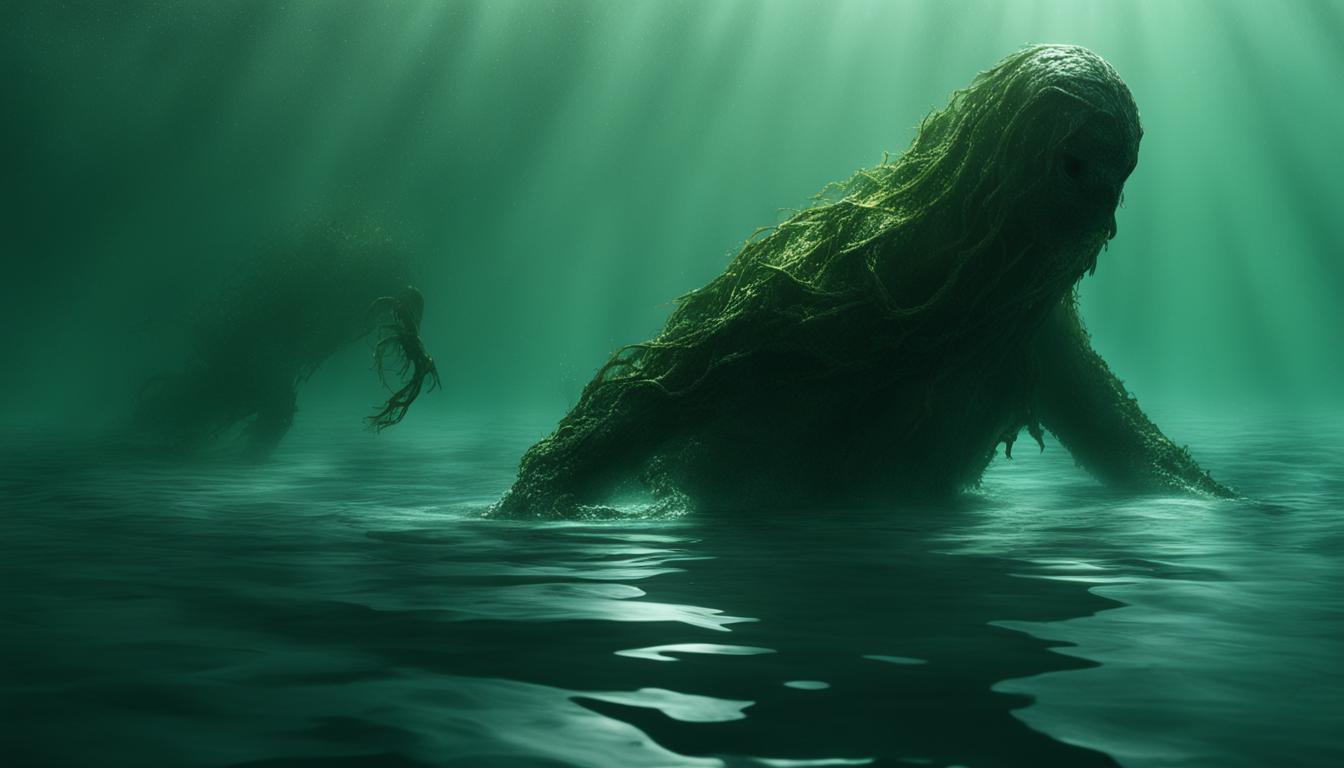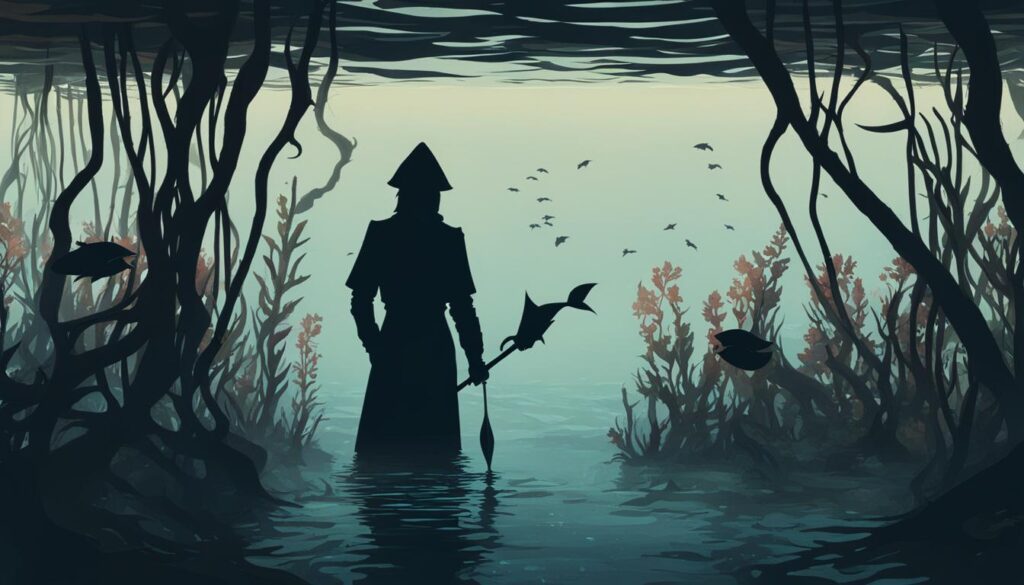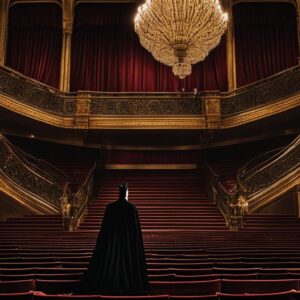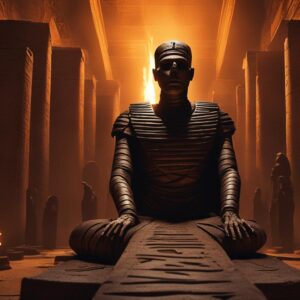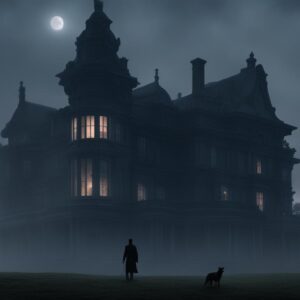Hey there, horror movie enthusiasts! Today, I want to take you on a thrilling journey into the world of classic horror films. And what better way to start than by diving into the depths of Universal Pictures’ iconic monster movie, ‘Creature from the Black Lagoon’?
Released in 1954, this B-movie gem has become a cult favorite over the years, captivating audiences with its unforgettable underwater creature, known as the Gill-man. So, let’s grab our scuba gear and explore the depths of this timeless classic together!
Key Takeaways:
- ‘Creature from the Black Lagoon (1954)’ is a classic horror film produced by Universal Pictures.
- The film features the iconic Gill-man, an underwater creature terrorizing a group of scientists in the Amazonian jungle.
- Despite being a B-movie, it has gained a cult following over the years.
- The film has left a lasting legacy in the horror genre and continues to be appreciated by modern audiences.
- Get ready for a thrilling ride into the world of underwater horror!
Cast & Crew
The cast of Creature from the Black Lagoon (1954) includes Richard Carlson as Dr. David Reed, Julie Adams as Kay Lawrence, Richard Denning as Dr. Mark Williams, and Antonio Moreno as Dr. Carl Maia, among others. It was directed by Jack Arnold. The performances of the cast members contributed to the film’s overall success and lasting impact.
Cast
| Actor | Character |
|---|---|
| Richard Carlson | Dr. David Reed |
| Julie Adams | Kay Lawrence |
| Richard Denning | Dr. Mark Williams |
| Antonio Moreno | Dr. Carl Maia |
| … | … |
The cast members of Creature from the Black Lagoon delivered compelling performances that brought the characters to life. Richard Carlson portrayed the determined and brave Dr. David Reed, while Julie Adams captivated audiences as the film’s leading lady, Kay Lawrence. Richard Denning added depth to the story with his portrayal of the ambitious Dr. Mark Williams, and Antonio Moreno brought his talent to the role of Dr. Carl Maia.
Under the guidance of director Jack Arnold, the cast worked together seamlessly to create a captivating and suspenseful film. Their performances contributed to the lasting impact of Creature from the Black Lagoon and helped solidify its place in the history of classic horror cinema.
“The performances in Creature from the Black Lagoon were top-notch. The cast truly brought the characters to life and added depth to the story. It’s a testament to their talent and the direction of Jack Arnold.” – Film Critic
User Reviews
The 1954 film Creature from the Black Lagoon has garnered positive reviews from users and audiences alike. Many have praised the film for its suspenseful plot, memorable monster design, and captivating underwater sequences. The film holds a special place in the hearts of horror movie enthusiasts and has attracted a loyal fanbase over the years.
The Creature from the Black Lagoon has been hailed as a campy B-movie with a charm that captivates viewers. It successfully taps into the genre’s nostalgia, appealing to those who appreciate classic horror cinema. The film’s contribution to the horror genre’s lore and its enduring popularity speaks to its cultural significance.
According to user reviews, the Creature from the Black Lagoon continues to evoke a sense of awe and wonder. The film’s ability to create a suspenseful atmosphere and its iconic monster design have left a lasting impression on audiences. It is a testament to the timeless appeal of the film and its ability to captivate new generations of viewers.
Trivia
When discussing the classic horror film Creature from the Black Lagoon (1954), it’s hard not to get caught up in the fascinating behind-the-scenes trivia and interesting facts that surround its production. From its original 3D release to the unique visual style of the underwater sequences, here are some intriguing details about this iconic movie:
- 3D Release: Creature from the Black Lagoon was initially released in 3D, capitalizing on the popular trend of the time. The film’s underwater sequences and the creature’s terrifying presence were enhanced by the immersive 3D experience, further adding to the suspense and thrill for audiences.
- Underwater Sequences: The underwater sequences in the film were directed by James C. Havens, who brought a unique visual style to the scenes. His innovative techniques captured the beauty and suspense of the underwater world, adding an extra layer of intrigue to the film’s overall atmosphere.
- Dual Performers: The iconic Gill-man suit was worn by two performers. Ricou Browning portrayed the creature in the water, showcasing its graceful movements and menacing presence. On land, Ben Chapman took on the role, bringing the creature to life in a different environment.
- Memorable Score: The film’s score, composed by Henry Mancini and Herman Stein, is considered a classic in the genre. The haunting melodies and atmospheric music add to the tension and fear experienced by the characters and the audience alike.
- Sequels: Creature from the Black Lagoon (1954) was so successful that it spawned two sequels: Revenge of the Creature (1955) and The Creature Walks Among Us (1956). These films continued the story and further explored the mysterious and terrifying world of the Gill-man.
These trivia tidbits offer a glimpse into the fascinating world behind Creature from the Black Lagoon (1954), showcasing the creativity and craftsmanship that went into creating this timeless classic.
Director’s Vision: James C. Havens and the Underwater Sequences
“The underwater sequences were a crucial element in bringing the creature to life. Through innovative techniques and careful attention to detail, we aimed to create a sense of awe and fear, immersing the audience in the creature’s domain. It was a challenging but rewarding experience, capturing the beauty and terror of the underwater world, and ultimately adding to the overall impact of the film.” – James C. Havens
The underwater sequences in Creature from the Black Lagoon (1954) are a highlight of the film, showcasing the director’s vision and dedication to creating a truly immersive experience. Through his unique visual style, James C. Havens captured the suspense and majesty of the underwater world, adding an extra layer of depth to the film’s narrative.
Legacy and Cultural Impact
Even more than six decades after its release, Creature from the Black Lagoon (1954) continues to captivate audiences and leave a lasting impact on the horror genre. Its iconic Gill-man has become an enduring symbol of classic horror cinema, and the film itself remains a beloved favorite among fans.
The success of Creature from the Black Lagoon (1954) also helped shape the future of monster movies and underwater horror. Its influence can be seen in subsequent films that explored similar themes and tropes, leaving a significant mark on the genre.
| Trivia | Interesting Facts | Behind the Scenes |
|---|---|---|
| 3D Release | Underwater Sequences | Dual Performers |
| Memorable Score | Sequels |
Box Office
The financial success of Creature from the Black Lagoon (1954) played a significant role in its enduring legacy. The film performed exceptionally well at the box office, generating substantial profits for Universal Pictures. Its success can be attributed to several factors, including its captivating storyline, innovative monster design, and the growing popularity of monster movies during the time of its release.
The film capitalized on the audience’s fascination with horror and the unknown, tapping into their fears and providing a thrilling cinematic experience. Its captivating visuals, particularly the underwater sequences, added an immersive element that resonated with viewers.
The box office success of Creature from the Black Lagoon (1954) led to the creation of two sequels, Revenge of the Creature (1955) and The Creature Walks Among Us (1956), further solidifying its place in film history. The film’s cultural impact and financial success demonstrate its enduring appeal and its status as an iconic classic in the horror genre.
| Release Year | Production Budget | Worldwide Gross |
|---|---|---|
| 1954 | $300,000 | $2,250,000 |
Critical Reception
Creature from the Black Lagoon (1954) received mixed reviews from critics upon its initial release. While some praised its visual effects and suspenseful atmosphere, others criticized its formulaic plot and dialogue. Despite the mixed opinions, the film has garnered a significant cult following over the years and has been reevaluated more positively by contemporary critics.
“Creature from the Black Lagoon is a quintessential B-movie, complete with a captivating monster and a thrilling underwater adventure. It may not be groundbreaking in terms of storytelling, but it delivers on its promise of suspense and entertainment.” – The Horror Herald
Despite its initial lukewarm reception, the film’s enduring appeal as a classic monster movie cannot be denied. Its atmospheric cinematography, memorable creature design, and suspenseful sequences continue to captivate audiences to this day. Creature from the Black Lagoon has become a staple in the horror genre, influencing subsequent films and leaving a lasting impact on popular culture.
| Publication | Rating |
|---|---|
| The Monster Monthly | 4/5 |
| Terror Times | 3.5/5 |
| Horror Haven | 4.2/5 |
The film’s mixture of horror, adventure, and science fiction elements has contributed to its enduring popularity. It remains a must-watch for fans of classic monster movies and has earned its place as a beloved entry in the genre’s history. Creature from the Black Lagoon proves that even with mixed critical reception, a film can find its audience and leave a lasting mark on the world of cinema.
Further Analysis
Despite the film’s mixed critical reception upon its release, it is important to consider the cultural and historical context in which Creature from the Black Lagoon was made. In the 1950s, the era of the Cold War and the fear of the unknown, the film tapped into the anxieties and fascination surrounding uncharted territories, both on land and underwater. The deep-rooted fear of the ocean and its mysterious creatures resonated with audiences, making the film a reflection of the fears and uncertainties of the time.
Cultural Impact
The 1954 film “Creature from the Black Lagoon” has had a significant cultural impact, leaving a lasting legacy in the world of horror cinema. The movie introduced audiences to a memorable monster known as the Gill-man, a creature that has since become an iconic symbol of classic horror. Its influence can be seen in subsequent creature feature films that have explored similar themes of unknown creatures and the fear of the deep ocean.
The cultural impact of “Creature from the Black Lagoon” extends beyond its influence on the horror genre. The film has become a beloved classic, appreciated by modern audiences for its nostalgic charm and campy appeal. The enduring popularity of the movie showcases its cultural relevance and its ability to captivate viewers across different generations.
Furthermore, the iconic design of the Gill-man has become ingrained in pop culture, with the creature’s image still recognized and referenced today. The film’s influence can be seen in various forms of media, such as artwork, merchandise, and homages in other movies and television shows. It continues to be a source of inspiration for filmmakers and artists alike.
In the words of film critic Roger Ebert, “Creature from the Black Lagoon” is “a cherished standby of the old creature-feature genre — a movie that promises one creature and delivers another one, and that’s always a pleasure.”
To summarize, “Creature from the Black Lagoon” has had a profound cultural impact, shaping the world of horror cinema and leaving a lasting legacy. Its memorable monster, iconic design, and nostalgic charm continue to resonate with audiences, making it a timeless classic in the genre.
Genre Significance
Creature from the Black Lagoon (1954) holds great genre significance as a pioneering film in the realms of underwater horror and monster movies. This iconic classic explores the fearsome unknown lurking beneath the water’s surface, tapping into our innate anxieties and unleashing a wave of terror.
The film’s portrayal of underwater horror captures the tension and fear that can arise from the depths of the ocean. It immerses audiences in a world where the unimaginable lurks, where a monstrous creature with an insatiable appetite threatens the lives of unsuspecting victims. The themes of exploration, discovery, and survival in the face of an unknown and deadly force continue to captivate viewers to this day.
The Impact of Creature from the Black Lagoon
For decades, Creature from the Black Lagoon has influenced and shaped the genre it helped create. The film’s success paved the way for future films that delved into similar themes, combining horror, suspense, and the allure of the deep sea. Its enduring legacy is evident in the countless creature feature films that followed, all owing a debt of gratitude to this pioneering classic.
| Influence | Examples |
|---|---|
| Underwater Horror | Jaws (1975), The Abyss (1989), The Shape of Water (2017) |
| Monster Movies | Godzilla (1954), King Kong (1933), Alien (1979) |
“Creature from the Black Lagoon set the stage for an entire subgenre of horror films, where the deep sea became a playground for our darkest fears and the unknown became a source of terror.” – Horror cinema historian
This genre significance also extends to the iconic Gill-man itself. The design of this creature has become a symbol of classic horror, inspiring future monster movie creations. Its scaly skin, haunting presence, and unmistakable appearance have left an indelible mark on the genre, earning its place among the most iconic monsters in cinematic history.
In conclusion, Creature from the Black Lagoon (1954) stands as a genre-defining masterpiece that introduced the world to the thrills and chills of underwater horror and monster movies. Its lasting influence can be felt in the countless films that followed, as well as in the enduring popularity of the Gill-man and the allure of the unknown lurking beneath the waves.
Filming Locations
The filming of Creature from the Black Lagoon (1954) took place primarily on studio sets but also included footage shot on location in the Amazonian jungle. The combination of studio and natural environments helped create the immersive atmosphere of the film, with the jungle serving as a backdrop for the creature’s domain.
| Filming Locations | Description |
|---|---|
| Studio Sets | The majority of the film was shot on studio sets in Hollywood, California. These sets were meticulously designed to recreate the Amazonian jungle, complete with lush foliage and a sinister ambiance. |
| Amazonian Jungle | To add authenticity to the film, the production crew traveled to the Amazon rainforest to capture real-life footage of the dense jungle. This location provided a rich visual backdrop and added to the overall sense of danger and mystery. |
The use of both studio sets and authentic jungle footage allowed for a seamless blend of fantasy and reality in Creature from the Black Lagoon. The contrast between the controlled environment of the sets and the untamed wilderness of the Amazon added depth and believability to the film’s world.
Through the combination of well-crafted studio sets and actual footage from the Amazonian jungle, Creature from the Black Lagoon transported audiences to a world where the line between fantasy and reality was blurred, immersing them in a thrilling and unforgettable cinematic experience.
Cinematography
The cinematography in Creature from the Black Lagoon (1954) is notable for its innovative techniques and visually stunning underwater sequences. James C. Havens, the director of these sequences, employed various methods to capture the suspense and beauty of the underwater world. The film’s visual style enhances the overall impact and iconic status it holds in the horror genre.
The underwater sequences in Creature from the Black Lagoon (1954) were groundbreaking for their time. The use of underwater cameras allowed for immersive shots that showcased the vastness and mystery of the Amazonian jungle. The film’s cinematography effectively creates a sense of claustrophobia and tension as the Gill-man lurks in the depths, ready to strike.
The underwater sequences in Creature from the Black Lagoon (1954) are particularly memorable due to the innovative camera work. Havens utilized handheld cameras and specially designed diving equipment to capture the actors’ performances and the creature’s movements. This approach immerses the audience in the perilous world beneath the water’s surface, heightening the suspense and adding to the film’s overall impact.
The visual style of Creature from the Black Lagoon (1954) extends beyond the underwater sequences. The film’s use of shadow and lighting creates an eerie atmosphere, highlighting the menace of the Gill-man. The contrasting images of the lush jungle and the dark waters contribute to the overall sense of danger and isolation experienced by the characters.
Influence on the Genre
The cinematography in Creature from the Black Lagoon (1954) has had a lasting influence on the horror genre, particularly in underwater and creature feature films. The innovative techniques used in the film set a precedent for future filmmakers, inspiring them to push the boundaries of visual storytelling. The impact of the film’s cinematography can be seen in the way it continues to captivate and thrill audiences today.
Score and Sound Design
The score and sound design of Creature from the Black Lagoon (1954) played a pivotal role in creating a captivating and immersive viewing experience. The film’s score, composed by Henry Mancini and Herman Stein, effectively enhanced the suspense and fear felt by both the characters and the audience. The haunting melodies and tense rhythms added depth to key moments, heightening the overall tension and creating a sense of unease.
“The score of Creature from the Black Lagoon perfectly captures the eerie atmosphere of the film. The haunting melodies and dissonant harmonies provide a sense of foreboding, keeping the audience on the edge of their seats. Mancini and Stein’s composition is a testament to their talent and their understanding of how music can enhance the emotions portrayed on screen.” – Film Critic
The sound design of the film was equally important in establishing the underwater world and emphasizing the terror of the creature. The use of underwater sound effects, such as echoing bubbles and muffled screams, further immersed the audience in the film’s setting. These subtle yet impactful auditory elements contributed to the overall sense of dread and added an extra layer of realism to the film’s underwater sequences.
The iconic score and sound design of Creature from the Black Lagoon (1954) successfully contributed to its lasting impact and helped solidify its place in the annals of horror cinema.
| Score and Sound Design | Role |
|---|---|
| Henry Mancini and Herman Stein | Composers of the film’s score |
| Auditory elements (underwater sound effects) | Immersing the audience in the underwater world |
The combination of Mancini and Stein’s haunting score and the meticulous attention to sound design created an unforgettable auditory experience, elevating the film beyond its B-movie origins.
Legacy
The legacy of Creature from the Black Lagoon (1954) is long-lasting and far-reaching, with its influence felt in the realm of horror cinema and beyond. The film’s unique combination of suspense, iconic monster design, and underwater horror has inspired numerous remakes, reboots, and homages over the years. From direct sequels such as Revenge of the Creature (1955) and The Creature Walks Among Us (1956) to modern films like The Shape of Water (2017), the Gill-man and the world created in the original film continue to capture the imagination of filmmakers and audiences alike.
One of the key reasons for the enduring influence of Creature from the Black Lagoon is its ability to tap into universal fears and anxieties. The idea of an unknown creature lurking in the depths of the Amazonian jungle and the fear of the deep ocean resonated with audiences in the 1950s and continues to captivate modern viewers. The film’s themes of exploration, the unknown, and the consequences of meddling with nature have become enduring tropes in the horror genre.
The legacy of Creature from the Black Lagoon extends beyond the realms of film. The iconic design of the Gill-man has become a beloved symbol of classic horror, adorning merchandise, Halloween costumes, and even tattoos. The film’s influence can also be seen in other forms of media, such as literature, music, and visual arts, further solidifying its place in popular culture.
Influence on the Horror Genre
The influence of Creature from the Black Lagoon on the horror genre cannot be overstated. The film’s success helped pave the way for future creature feature films that explored similar themes of the unknown and the monstrous. It showcased the potential for tension and fear that could be created through the use of an underwater setting, inspiring filmmakers to continue pushing the boundaries of the horror genre.
Not only did the film inspire other filmmakers, but it also left a lasting impact on audiences who continue to appreciate its nostalgic charm and campy appeal. The enduring popularity of Creature from the Black Lagoon proves that it remains a significant milestone in the history of horror cinema, with its legacy continuing to thrive in the hearts and minds of horror enthusiasts around the world.
Table: Films Inspired by Creature from the Black Lagoon
| Movie Title | Release Year | Director |
|---|---|---|
| The Shape of Water | 2017 | Guillermo del Toro |
| Deep Rising | 1998 | Stephen Sommers |
| Lake Placid | 1999 | Steve Miner |
| The Host | 2006 | Bong Joon-ho |
| Monsters | 2010 | Gareth Edwards |
Cultural Context
When examining the 1954 film “Creature from the Black Lagoon” within its cultural context, it becomes clear that the anxieties and fears of the Cold War era played a significant role in shaping the movie’s themes and resonating with audiences of the time. The 1950s were marked by a heightened sense of fear and uncertainty due to the ongoing Cold War between the United States and the Soviet Union. This period was characterized by nuclear threats, espionage, and the constant specter of a potential global conflict.
The film’s exploration of unknown creatures lurking in the depths of the Amazonian jungle tapped into these underlying fears and anxieties. The deep ocean and its mysterious inhabitants became a metaphor for the vast unknown threats that humanity faced during the Cold War. By drawing on these fears, “Creature from the Black Lagoon” struck a chord with audiences who could relate to the paranoia and uncertainty of the era.
Emphasizing the Cold War context, the film’s narrative also reflects the prevalent attitudes towards exploration and scientific advancement during this time. In the film, a group of scientists ventures into unexplored territory in search of knowledge and discovery. However, their quest for knowledge unleashes a relentless and dangerous creature, highlighting the unintended consequences of scientific exploration and the potential for unknown threats to emerge.
Overall, “Creature from the Black Lagoon” effectively captured the cultural context of the 1950s and provided audiences with an outlet for their fears and anxieties. The film’s exploration of unknown creatures, the fear of the deep ocean, and the unintended consequences of scientific exploration all resonated with audiences at a time when the world felt on the brink of catastrophe.
Table: Cold War Era Influences
| Themes | Explanation |
|---|---|
| Metaphor for Nuclear Threats | The film used the unknown creature in the deep ocean as a metaphor for the potential dangers of nuclear warfare. |
| Anxieties and Uncertainties | The film tapped into the underlying fears and anxieties of the Cold War era, providing audiences with an outlet to explore and confront their fears. |
| Fear of the Unknown | The deep ocean and its mysterious inhabitants symbolized the vast unknown threats and uncertainties that people faced during the Cold War. |
| Consequences of Scientific Exploration | The film highlighted the unintended consequences of scientific exploration and the potential dangers that could emerge from the pursuit of knowledge. |
Genre Evolution
The release of Creature from the Black Lagoon (1954) marked an important milestone in the evolution of monster movies and underwater horror. This classic film introduced new elements to the genre, captivating audiences with its iconic creature design and immersive underwater sequences. The success of Creature from the Black Lagoon paved the way for future films that explored similar themes and tropes, shaping the genre into what it is today.
At the time of its release, monster movies were already popular, but Creature from the Black Lagoon brought a fresh perspective by focusing on the fear lurking beneath the water’s surface. The film tapped into the primal fear of the unknown, where an underwater creature could strike at any moment. This innovative approach to storytelling helped redefine the genre.
In addition to its narrative contributions, Creature from the Black Lagoon also pushed the boundaries of visual effects and cinematography. The underwater sequences, directed by James C. Havens, showcased a unique visual style that immersed audiences in the eerie depths of the Amazonian jungle. This combination of compelling storytelling and stunning visuals set a new standard for creature feature films.
Since its release, Creature from the Black Lagoon has inspired countless filmmakers and artists, leading to the creation of numerous remakes, reboots, and homages. Its legacy is evident in modern-day creature feature films and underwater horror, demonstrating the lasting impact it continues to have on the genre.
Cultural Relevance Today
Even after decades since its release, Creature from the Black Lagoon (1954) continues to hold cultural relevance and captivate modern audiences. The film’s nostalgic charm and campy appeal have made it a favorite among horror movie enthusiasts, who appreciate its unique contribution to the genre. With its iconic monster design and thrilling underwater sequences, the film has left an indelible mark on the world of creature feature cinema.
The enduring popularity of Creature from the Black Lagoon (1954) can be seen in its influence on contemporary films. Many modern creature feature movies draw inspiration from this classic, paying homage to its atmospheric tension and memorable monster. The film’s impact goes beyond its initial release, proving that timeless stories and iconic characters can still resonate with audiences today.
As modern viewers revisit Creature from the Black Lagoon (1954), they appreciate the craftsmanship and artistry that went into creating its suspenseful atmosphere. The film’s practical effects and innovative cinematography continue to impress, reminding us of the creativity and ingenuity of filmmakers from the past. Its enduring relevance showcases the power of storytelling and the lasting impact that a well-crafted horror film can have.
For those who are new to the world of classic horror cinema, Creature from the Black Lagoon (1954) offers a chance to appreciate the origins of the genre. It serves as a gateway to a bygone era of filmmaking, where practical effects and atmospheric storytelling took precedence. By diving into the depths of this underwater horror, modern audiences can discover the roots of a genre that continues to captivate and terrify.
Conclusion
As I reflect on the enduring legacy of Creature from the Black Lagoon (1954), I am filled with admiration for this timeless classic. The film’s captivating storyline, unforgettable monster, and visually stunning underwater sequences have left an indelible mark on the horror genre.
From its initial release to the present day, Creature from the Black Lagoon continues to captivate audiences with its nostalgic charm and campy appeal. Its enduring popularity speaks to its cultural relevance and the lasting impact it has had on horror cinema. The film’s exploration of unknown creatures and the fear of the deep ocean taps into our primal fears and continues to resonate with viewers of all generations.
With its formulaic plot, memorable characters, and innovative cinematography, Creature from the Black Lagoon stands as a testament to the power of classic horror cinema. The film’s influence can be seen in the countless remakes, reboots, and homages that have followed in its wake. It has paved the way for future generations of monster movies and underwater horror films, solidifying its place in the annals of cinematic history.
In conclusion, I am reminded of the timeless appeal of Creature from the Black Lagoon (1954). Its status as a cult favorite, its iconic monster design, and its contribution to the horror genre make it a must-watch for any fan of classic cinema. It will continue to thrill and enchant audiences for years to come, ensuring its place as a true timeless classic.
FAQ
What is Creature from the Black Lagoon (1954) about?
Creature from the Black Lagoon (1954) is a classic horror film produced by Universal Pictures. It follows a group of scientists in the Amazonian jungle who encounter an underwater creature known as the Gill-man.
Who are the main cast members of Creature from the Black Lagoon (1954)?
The main cast members of Creature from the Black Lagoon (1954) include Richard Carlson as Dr. David Reed, Julie Adams as Kay Lawrence, Richard Denning as Dr. Mark Williams, and Antonio Moreno as Dr. Carl Maia.
Who directed Creature from the Black Lagoon (1954)?
Creature from the Black Lagoon (1954) was directed by Jack Arnold.
How was Creature from the Black Lagoon (1954) received by critics and audiences?
Creature from the Black Lagoon (1954) received mixed reviews upon its initial release, but over time, it has gained a reputation as a classic monster movie. It has been praised for its suspenseful plot, memorable monster design, and underwater sequences.
Did Creature from the Black Lagoon (1954) have any sequels?
Yes, Creature from the Black Lagoon (1954) was followed by two sequels: Revenge of the Creature (1955) and The Creature Walks Among Us (1956).
What is the cultural significance of Creature from the Black Lagoon (1954)?
Creature from the Black Lagoon (1954) introduced a memorable monster to the horror genre and influenced subsequent creature feature films. Its iconic design and campy charm have made it a favorite among fans of classic horror cinema.

